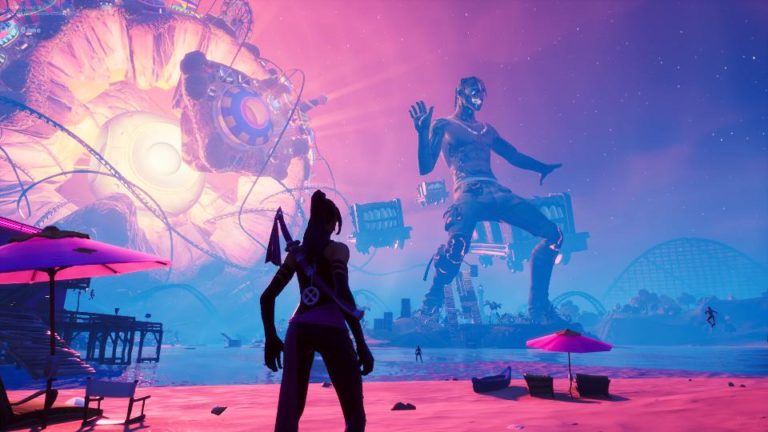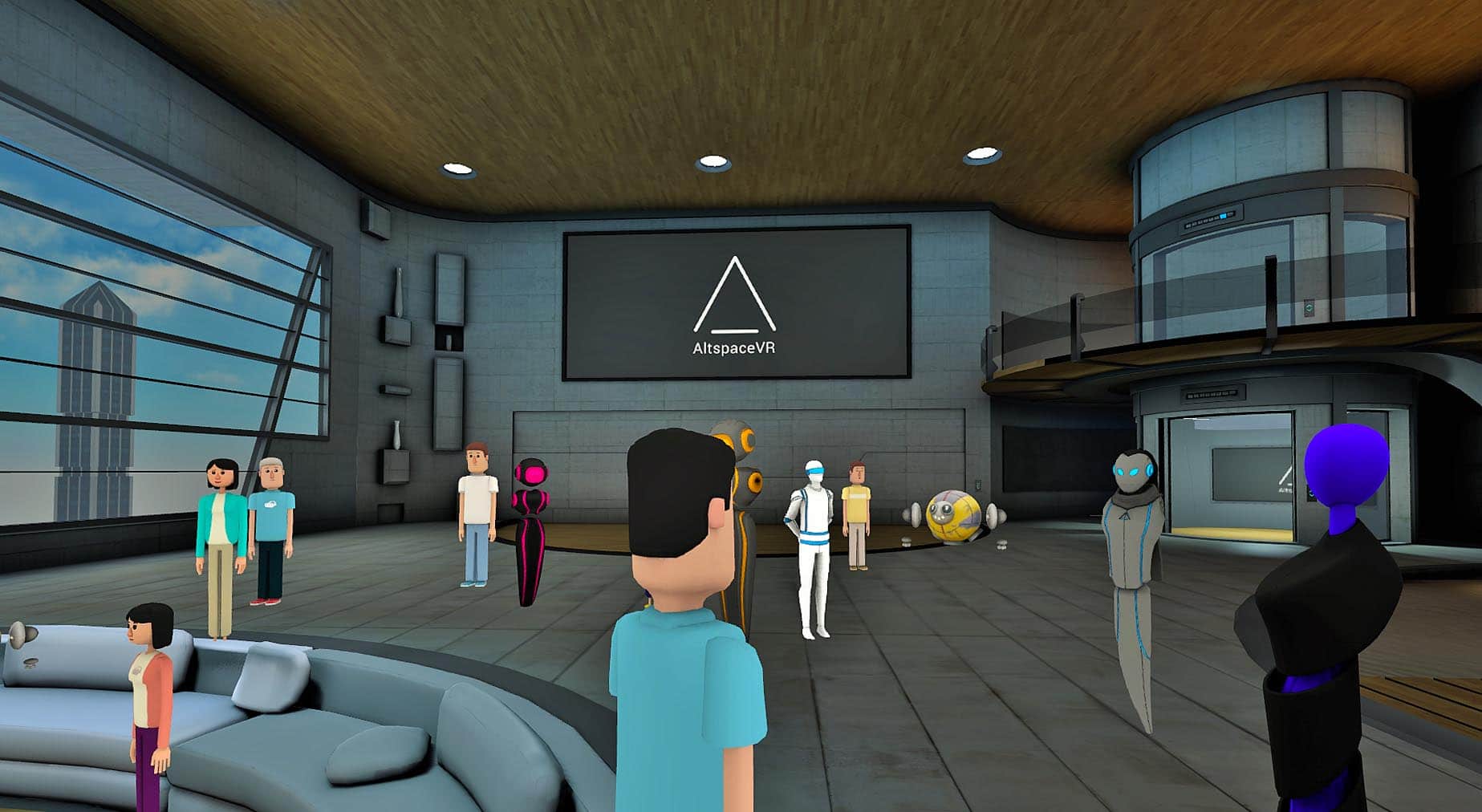
“Trendline” is AR Insider’s series that examines trends and events in spatial computing, and their strategic implications. For an indexed library of spatial computing insights, data, reports and multimedia, subscribe to ARtillery PRO.
One of the many questions being asked around “new normal” business dynamics is how will industry events play out? Will the surge in generation-Zoom continue? Or will something with greater fidelity and immersion win. In other words, is this VR’s chance to shine?
After examining those questions and potential business models in Part I of this series — plus some VR event platform tryouts — more has come to light. We’ve had feedback and healthy debate (more on that in a bit) but the most noteworthy item happened last week in Fortnite.
As Charlie Fink reports,* the game hosted a live Travis Scott concert in its multi-player sandbox. Players could navigate their avatars around the Fortnite gamescape while Scott loomed over as a massive Kaiju-sized avatar of himself, performing and teleporting around the space.
Most notable about the event — besides the user experience and creative application of a semi-new performance medium — was its scale. 12.3 million people attended virtually, which counts players in the game, but undercounts the larger total of friends and family that could watch along.
To clarify, this isn’t VR. Though Fortnite is 3D multi-player, it’s mostly played on PCs, consoles and mobile devices. But it’s made by Epic Games whose Unreal Engine is used in VR development. Could this, or something like it, portend the future of VR events? Some are already trying.
Inherent Scale
Zeroing in on the 12.3 million users, this gets to one point we made in Part I of this series that virtual events are advantaged by the internet’s inherent scale. Though virtual events have disadvantages, it’s all about zeroing in and cultivating the things they’re good at.
Tackling the disadvantages first, it depends on the event type. Last week we discussed the drawbacks of virtual business events. But sticking with the Travis Scott example, there’s an even-greater quality variance between virtual and physical when we’re talking about a concert.
Here we’ll rely on the already-great analysis provided last week by Robert Scoble on the irreplaceable ethos of live music events. One takeaway from his article is that attempting to replicate core endemic aspects of live music through a virtual medium is a losing battle.
Instead, do something completely different. Produce an event that’s advantaged, rather than disadvantaged, by its own medium. What are those production tactics? We don’t know yet, but someone will innovate around “new-normal” constraints, as it often goes when the ground shifts.

Best of Both Worlds
Some of that was seen in the Travis Scott concert. It’s scale, again, is a benefit that’s unique to the medium. Avoiding long lines, getting a front-row seat, and experiencing it all from the comfort of your couch are a few perks. More compelling and immersive features will be discovered.
For example, are there social dynamics or digital network effects that can’t be done IRL? Can virtual private areas be created (or sold) for your family, fan club or far-flung affinity groups? Can VIP sections be gamified (it is a game after all) to create scarcity and competitive drive?
The answer is that many tracks could develop, each optimized for different contexts. In cases where scale and accessibility are the goals, the virtual route can be taken. In less frequent but more meaningful occurrences (and when things return to normal), physical events can live on.
Having a sliding scale to play with could engender optionality and nuance. It’s like my iPhone that can’t compete with the optical range of my DSLR rig, but is more accessible and nimble in most cases. Could event modalities co-exist in similar ways to offer both scale and depth of experience?
Back to Business
Moving from concerts to conferences, how do the above principles apply? In Part I, we discussed how digital network effects could improve sales funnels and warm leads for BD folks by filtering and targeting fellow attendees more intelligently, and with time-shifted pitch windows.
But even then, something’s still missing. Just like Scoble’s breakdown of the irreplaceable ethos of the analog, there are irreplaceable aspects of in-person event networking. A BD colleague told me in response to Part I that VR will never replace the boozy after-hours sale at the hotel bar.
And he’s right… VR can’t do that. But the point is that it shouldn’t try. VR events should rather create a new approach that’s inherently advantaged. Lacking depth of the late-night sale, can VR instead offer the above network effects to engender more deals or an equivalent bottom line?
A broader question is should networking be involved in VR events at all? We’re conditioned to think that events are all about knowledge-building and networking. That’s because those components aligned well with a physical events model…. but is the formula different in VR?

Common Denominator
This all leads to the question of if knowledge-building (panels, talks, etc.) should be de-coupled from virtual networking. Should they each have their own virtual format that’s optimized for unique goals, rather than forcing them together into common-denominator features of a single event?
In our pricing analysis in Part I, there can be favorable margins for $200 virtual events (compared to $1000 physical events plus $1000-$2000 travel expenses). At that price, the knowledge-building aspects of virtual events could provide sufficient value. And networking can be done elsewhere.
Just like concerts, there could be two modalities. Educational talks can be given in a way that lets them shine, while networking is done through a filtered and network-effect driven speed dating format (or the Chatroulette-meets-VR format we’ve speculated) of a wholly-separate event.
Then eventually, physical events could return while virtual events continue with greater agility and frequency to scratch the knowledge-building itch. Collectively, a dual-mode scheme could let events optimize in ways they wouldn’t have discovered without a forced new perspective.
Then again, this is admittedly a lot of speculation and a thought exercise. This will continue to be new ground for all of us. But the good news is that that’s often where innovation lives.
For deeper XR data and intelligence, join ARtillery PRO and subscribe to the free AR Insider Weekly newsletter.
Disclosure: AR Insider has no financial stake in the companies mentioned in this post, nor received payment for its production. Disclosure and ethics policy can be seen here.
* Charlie Fink’s next book Remote Collaboration and Virtual Conference, The Future of Work is in progress for a planned Q2 launch
